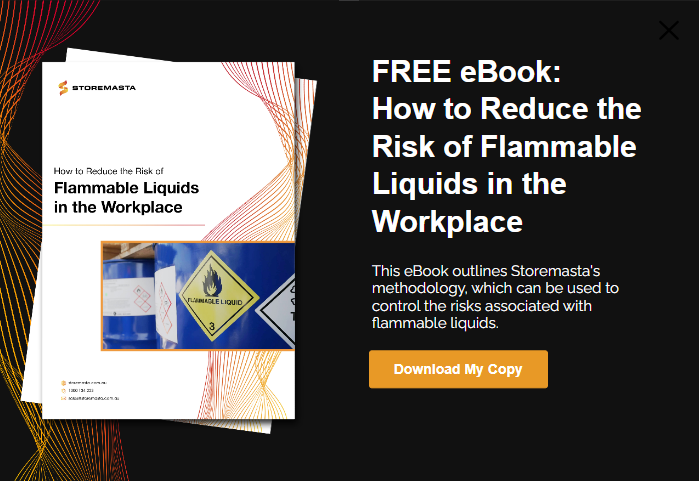Most organisations in the manufacturing, agriculture, mining, food & beverage, transport and vehicle maintenance and service industries would use combustible liquids on a day to day basis. Combustible liquids have many uses. Some combustible liquids such as diesel are used to fuel combustion engines and other combustible liquids such as oils and greases are used as lubricants.
What Are Combustible Liquids?
The Australian Standard AS1940-2017 defines combustible liquids as:
Combustible liquids are liquids that have a flash point and fire point that is below its boiling point. Combustible liquids are divided into two classes:
Class C1: A combustible liquid that has a closed cup flashpoint of greater than 60 °C but less than 93 °C.
Class C2: A combustible liquid that:
- Has a flashpoint of greater than 93 °C
- Has been excluded from being classified as a flammable liquid by any of the criteria for sustaining combustion.
Combustible liquids have similar properties to flammable liquids. The difference lies in their flash point range. Combustible liquids have a higher flash point than flammable liquids and therefore they are less volatile. Flammable liquids and combustible liquids are both liquids that can burn.
Examples of combustible liquids
As outlined above, combustible liquids are used by many organisations covering a wide range of industries. This is because combustible liquids come in many different forms and have a number of uses. They can be used as fuels, lubricants and cleaning agents. Some examples of combustible liquids include:
- Diesel fuel
- Engine oil
- Fuel oil
- Acetic acid
- Kerosene
- Linseed oil
- Ethylene glycol
Combustible liquids storage and handling standards
The Australian Standards that outlines the requirements for the storage and handling of combustible liquids is AS1940-2017 - The storage and handling of flammable and combustible liquids. This standard outlines the requirements for the design, construction and operation of facilities used for the storage of combustible liquids. Adhering to the requirements of AS1940 is accepted as a compliant solution for meeting the legislative requirements for the storage and handling of combustible liquids. The storage requirements for combustible liquids are very similar to the storage requirements for flammable liquids and the requirements for each are outlined in the same Australian Dangerous Goods Standard.
The Australian Standards are not law, however if they are mentioned in a dangerous goods Act or Regulation, non-adherence to the Australian Standards could lead to prosecution. Therefore it is very important to store combustible liquids in full conformance to AS1940 to reduce the risk of financial liability due to non-compliance.
How to safely store combustible liquids
To store combustible liquids in a way that reduces risk to people, property and environment, it’s very important to store them in a facility that meets the requirements of AS1940. A facility that meets the requirements of AS1940 must meet specific requirements in regards to:
- Ventilation
- Spill containment
- Dangerous Goods signage
- Segregation from incompatible chemicals
- Separation from ignition sources and protected places.
When combustible liquids are subject to higher temperatures, they will give off vapours that can ignite in the presence of an ignition source. To reduce the risk of ignition, it’s important to ensure that all stores used for the storage of combustible liquids have a ventilation system that keeps the concentration of vapours at a safe limit.
Combustible liquids can cause a lot of damage to the environment. When spilled they also increase the risk of slip and fall injuries. To ensure that the people and environment of your organisation are protected from combustible liquid spills, all cabinets and containers used for the storage of combustible liquids must have a spill containment sump. The capacity of the spill containment sump must meet the requirements outlined in AS1940.
To warn workers and visitors of the potential risks associated with combustible liquids, stores and cabinets used to store these liquids must display clear dangerous goods signage. This will include a combustible liquids label.
There are a number of other classes of dangerous goods that could increase the risk to people, property and the environment when mixed with combustible liquids. Some of these classes include:
- Class 5.1 Oxidising Agents
- Class 5.2 Organic Peroxides
- Class 6 Toxic Substances
- Class 8 Corrosive Substances
In some cases the mixing of incompatible classes of dangerous goods can cause violent chemical reactions. To avoid these violent reactions different classes of dangerous goods must be segregated by certain distances outlined in the dangerous goods segregation chart.
At higher temperatures, combustible liquids will give of vapours that can ignite in the presence of an ignition source. To prevent the risk of fires, combustible liquids must always be segregated from ignition sources by at least 3 meters. Certain quantities of flammable liquids must also be separated from public places by certain distances. These distances are outlined in AS1940.
AS1940 outlines different requirements for indoor storage and outdoor storage. Combustible liquids can be safely stored indoors by using a compliant safety cabinet. Compliant outdoor storage can be achieved with a chemical storage container that meets the strict specifications outlined in section 4 of AS1940.
Next Steps
As combustible liquids will burn, it is very important to store them in a manner that reduces the risk of them coming into contact with an ignition source. It is also important to segregate them from other incompatible classes of dangerous goods. To avoid financial liability due to non-compliance, combustible liquids must be stored in full conformance to AS1940. For more information on how to reduce the risk of flammable and combustible liquids, download our FREE eBook by clicking on the image below.
Joining the team as a Dangerous Goods Storage Consultant, Melissa Hampton became Storemasta's Marketing Manager in late 2021. With extensive knowledge and experience in chemical compliance, Melissa is responsible for leading the Marketing team and helping shape their marketing strategy. In her spare time, you can find Melissa hiking, swimming and enjoying the great outdoors in beautiful north-west Tasmania.

